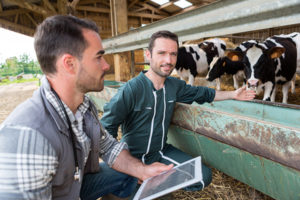The National Dairy FARM Program (Farmers Assuring Responsible Management)1 introduced several updates to it’s calf management guidelines which took effect January 1, 2017. The 2017 revision places greater emphasis on employee training and the Veterinarian-Client Patient relationship.
 Painful medical procedures and the need to manage the associated pain and stress to animals get detailed attention in this revision. Dehorning/disbudding, castration, branding, and extra teat removal are all procedures performed on calves and require pain management. The practice of tail docking was phased out as of January 1, 2017. Painful medical procedures and discussions of best practices are provided below.
Painful medical procedures and the need to manage the associated pain and stress to animals get detailed attention in this revision. Dehorning/disbudding, castration, branding, and extra teat removal are all procedures performed on calves and require pain management. The practice of tail docking was phased out as of January 1, 2017. Painful medical procedures and discussions of best practices are provided below.
Medical Procedures Requiring Pain Management
- Castration: castration is acutely painful regardless of procedure used. From an animal care perspective, Surgical and Burdizzo (crushing the chord) may be better options than Banding because pain can be minimized at the time of surgery and post-operative. Banding has less initial pain, but can be painful for several weeks after applying band or ring.
- Castration should be done at the youngest age possible, and regardless of procedure, immediate pain must be managed according to pain control methods agreed on by the dairy farmer and herd veterinarian.
- Extra Teat Removal: performed at the youngest possible age to minimize tissue damage and can be conducted concurrently with Dehorning/Disbudding to take advantage of pain relief provided at this time. Use pain management in accordance with recommendations of the herd veterinarian.
- Branding: Freeze branding is less painful than hot branding. Branding wounds are immediately painful and remain so for at least eight weeks. Brands must never be applied to the face. Farms should work with their veterinarians to determine the need for branding and opting for other forms of identification such as tamper-proof RFID if possible.
- Tail Docking. The National Dairy FARM Program opposes the routine tail docking of diary animals, except in extraodinary cases of traumatic injury to the animal. This practice was phased out January 1, 2017.
- Dehorning/Disbudding: conduct dehorning at earlier possible age, before 8 weeks of age. Local anesthesia, non-steroidal anti-inflammatory (NSAID) and sedatives provided benefit to calf welfare. Develop and effective pain management protocol with your veterinarian. Caustic paste also causes pain. Protect treated calves from rain and limit social interaction to ensure paste affects only the horn bud area.
Properly administered lidocaine can have a profound effect on the pain experienced by a calf during dehorning. This Calf Management Tips video demonstrates the proper techniques for administering lidocaine and dehorning.
Calf Management Tips: Lidocaine Blocking and Dehorning
Other Recommended Calf Management Practices Include…
Colostrum
- Acquired immunity from colostrum is the first and most important control measure for diarrhea.
- 4-5 quarts (10% of body weight) of high quality colostrum (Ig > 50 mg/ml or Brix > 22) in one or two feedings within the first 6-8 hrs of life.
- Minimum blood serum IgG of 10.0 g/L or minimum serum total protein of 5.5 g/dL
- Colostrum replacements providing 150 to 200 grams IgG are preferred
Milk or Milk Replacer Feeding
- 8 or more quarts in 2 or more feedings per day
- Feed via nipple feeding instead of a bucket. Nipple feeding is more natural and results in more digestive hormones. See the link “Bottles vs Pails” at the bottom of this post for a more complete discussion on the advantages of nipple feeding.
Starter and Water
- Begin introducing small amounts of fresh palatable high quality starter feed by day 3 and increase the amount offered as the calf consumes more over time
- Feeding milk or milk replacer should not be a substitute for water. Provide calves with access to water beginning on the first day of life. If continuous access is not possible, water must be made available to allow animals to drink to satiation at least twice per day, and more often during heat stress.
Weaning
- Reduce milk allowance gradually over a 7 to 10 day period. Gradual weaning is especially important when feeding large volumes of milk or milk replacer.
- Dilute the milk with water or slowly restrict the amount of milk to successfully achieve gradual weaning. This increases starter intake and minimizes the growth check at weaning.
Hygiene (score 1 = clean, 4 = dirty)
- A clean environment will help limit the influence of bacteria, viruses and protozoa, having a substantial impact on calf growth.
90% of all animals in all pens score 2 or less
Body Condition Score (BCS 1-4)
- 99% of all classes of animals with body condition score of 2 or more
Environment
- Temperature and Humidity: for calves less than 1 month of age, shield from drafts (wind speeds >50 ft per minute). Dry bedding is preferred for milk-fed calves and is essential in cold weather conditions. Higher milk/milk replacer feeding rates are required to supplement calories for growing calves and a deep bed of straw is recommended for nesting in cold climates. Supplement these cold weather strategies with clean calf jackets.
_________________________________
For more information on the FARM Program, check out the links below to the National Dairy FARM Program and to the Animal Care Manual and other program resources.
- Calf Feeding – Bottles vs. Pails
- National Dairy FARM Program website
- Version 3.0 Animal Care Manual download
